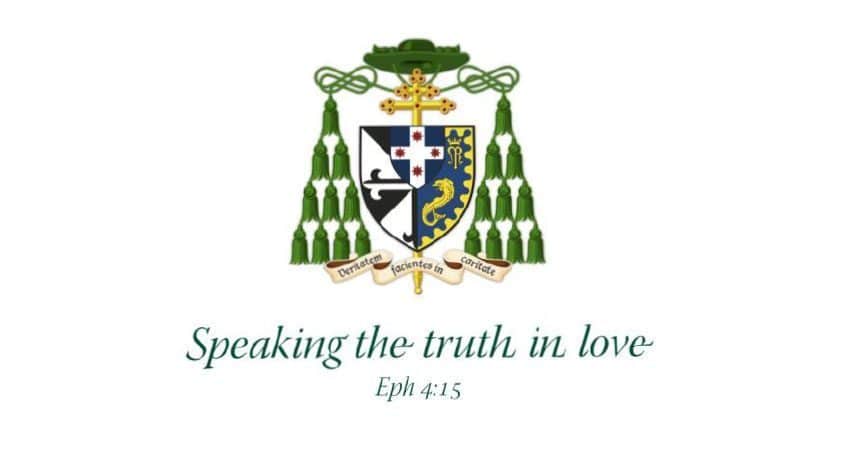Homily for Mass for the Feast of the Chair of the Apostle Peter

St Mary of the Cross Chapel, ACU Melbourne Campus, 22 February 2024
The recently aired ABC docuseries Nemesis offers a dramatic account of the internal wars, external challenges and multiple leadership coups of the Liberal-National Party coalition when in power from 2013 to ’22. In particular, it charts the rise and fall of Prime Ministers Tony Abbott, Malcolm Turnbull and Scott Morrison, based on interviews with two of them and a supporting cast of ministers and staffers. It’s a captivating tale of the perils of power and personality, the egos and alliances, principles and pragmatism, half-truths and full-on lies, loyalties and betrayals, and of the human beings who govern us.
Of course, the precariousness of holding high office, whether political, ecclesiastical, sporting or otherwise, is nothing new. The power that comes with leadership can be too much for some to handle and, as Lord Acton famously noted, it tends to corrupt, sometimes absolutely.[1] Personal ambition can get in the way of sound judgment, conviction be sacrificed for expediency, and the line between friend or foe ally or assassin, become blurred, leading to instability, paranoia and revenge.
Today, as I noted at the start of Mass, we celebrate not a person, place or event but a sacred office, represented by a chair. It’s from the Latin word for chair, cathedra, that we get our word ‘cathedral’, and so in celebrating the Chair of Peter we honour what the Office of the Bishop of Rome means for the whole Church. But why, we might wonder, is a chair the symbol? Why not the shepherd’s staff, or the keys, barque or tiara of Peter?
Well, in the Gospels, seats and sitting are rich in meaning. God the Father is said to be enthroned in the heavens, and Christ to be seated at His right hand, return to judge from His throne at the end of time. During His earthly life Pilate sits in judgment of Him, and the apostles share His authority and so are promised thrones too. Jesus often sits down to teach, like a professor traditionally did. In some Gospel situations, seating indicates honour; in others, listening, ease, communion.[2] So the bishop or pope’s chair represents an office of governing, judging, teaching, uniting.
In our Gospel (Mt 16:13-19), Simon boldly declares his faith, the faith of the Church: “You are the Christ, the Son of the living God.” He hadn’t come to this conclusion purely by his own observation and reasoning: no, Jesus says, the insight came from the Father. But he appropriated this God-given faith and was willing to profess it out loud, and this would be a rock-solid basis for Christ to build His Church. This faith in Christ as Son and Messiah was why Peter was chosen as key-bearer, the one with power to bind and loose—to declare, rule, canonise, absolve.
What mattered about Peter wasn’t the kind of charismatic personality our celebrity culture craves, nor the professional c.v. the business world rewards, nor the leadership experience politics requires. If anything, the gospels portray a man with multiple character flaws: impulsive and prone to babble and to gaffes; fickle in faith and so nearly drowning; failing in assignments as simple as staying awake; being hypocritical in dealing with Jewish-Gentile tensions; being an obstacle to Christ’s mission at times; and, of course, when push came to shove on that fateful night, thrice denying he even knew Jesus.[3]
Yet Jesus chose him. And, sure enough, he was the one who regularly saw who Jesus was and what He was about before the other disciples, who was their natural as much as their appointed leader after Christ, and who would give up his family, home, livelihood and ultimately his very life for the building up of God’s Church. After Pentecost Peter would preside, first over the nascent Church in the Upper Room, then taking his seat of authority in Antioch where we were first called ‘Christians’, and finally to Rome, where he would continue to feed the Lord’s sheep and in his old age, be bound and led “where he would rather not go”, to his upside-down crucifixion.[4]
So, was Pope Peter, CEO of Catholic Church Inc., markedly different from Simon the cocky and bumbling fisherman? Were his frailties as a human being erased once he took charge? I think not—just read Acts or Paul’s letters. But what clearly had changed was that that declaration he once made in Galilee, that Jesus is Son andMessiah, now animated his whole life and enabled his ‘Petrine’ ministry to serve the unity and fidelity of the Church to this day. It is through that chair of teaching and governing, absolving and communing, that the papacy has united “the brethren”, fed the lambs, guided the sheep, and ensured the Church would be one, holy, catholic and apostolic.
In his epistle today (1Pet 5:1-4), Peter offers advice to Church leaders. It’s rather different to the lessons you might get from the Nemesis series. Don’t lead through clenched teeth, out of mere duty, he says, as that’s a sure route to ulcers. Don’t lord it over others in a one-man show, that’s the stuff of dictators and ends in coups. Don’t obsess about your own wealth or ratings, that way madness lies. Instead, lead by example, watch over your charges gladly, be good caretakers until the Chief Shepherd appears. You can hear Jesus speaking here through Peter, as we always should. And the point is clear: power is no end in itself, and to think so is the way to hubris, misjudgement and ruin.
In the apse of St Peter’s Basilica in Rome, the 17th century the Italian master, Gian Lorenzo Bernini, encased the relic of the Cathedra Petri (Peter’s chair) in bronze and surmounted it above sculptures of four Church doctors, Augustine and Ambrose, Chrysostom and Athanasius. This highlighted Peter’s authority over the whole Church, but also his reliance on the faith and support of its members. Above the chair Bernini placed the colossal and resplendent Dove of the Holy Spirit, a window that sprawls light into the Basilica, illuminating all before it. Peter’s authority is grounded in the faith he received from God and which we all share and must all in turn protect and transmit: the faith in God’s love and truth poured forth on His beloved Church.
[1] See Lord Acton letter to Bishop Creighton correspondence, Letter 1 https://oll.libertyfund.org/titles/acton-acton-creighton-correspondence#
[2] God the Father is enthroned: e.g. Mt 23:22. Christ is seated at His right hand, a sign of honour and authority, and will return to judge from His throne: Mt 26:64; Mk 14:62; 16:19; Lk 22:69. Pilate sits in judgment of him: Mt 27:19; Jn 19:13. The apostles are promised thrones: Mt 19:28; Lk 22:30. Jesus sits to teach: Mt 5:1; 13:2; 15:29; 26:55; Mk 4:1; 9:35; Lk 4:20; 5:3; Jn 6:3; 8:2. Seating indicates honour: Mt 21:7; 23:6; 28:2; Mk 11:7; 12:39; 14:3; Lk 5:29; 10:39; 11:43; 14:10; 17:17; 20:46; 22:27; Jn 6:10; 12:14; 13:23. Seating indicates listening, being at ease, being in communion: Mt 9:10; 13:1; 26:7; Mk 2:15; 6:40; 16:14; Lk 7:36; 11:37; 17:17; 22:21; 24:30; Jn 6:11; 12:2; 13:4,12.
[3] Peter was impulsive and prone to gaffes: e.g. Mk 8:32-33. He failed in simple assignments like staying awake: Mt 26:40; Mk 14:37. He was at times an obstacle to Christ’s mission: Mt 16:23. He was fickle in faith and so nearly drowned: Mt 14:30-33. He made bad judgment calls including violence in Gethsemane: Jn 18:10-11. He was hypocritical in dealing with Jewish-Gentile tensions: Gal 2:11-13. And he betrayed the Lord on the night of his trials: Mt 26:69-75; Mk 14:66-72; Lk 22:54-62; Jn 18:15-17, 25-27.
[4] Simon as Cephas/Peter/Rock: Mt 4:18; 10:2; 16:16-19; Mk 3:16; Lk 6:14; Jn 1:42; 6:8,68; 13:6,9,24,36; 18:10,15,25; ch. 20; Acts 10:5; 11:13. Simon as spokesman: Mt 15:15; 16:16,22; 17:26; 18:21; 19:27; 26:33,35; Mk 8:29,32; 10:28; 11:21; 14:29; Lk 8:45; 12:41; Jn 13:6-9,36-37; Acts 1:15 etc. Simon as the one who knew Jesus best: Mt 17:4; Mk 9:5; Lk 5:8; 9:20,33; Jn 6:68. Simon as one of Jesus’ executive, closest to Him: Mt 17:1; 26:37; Mk 1:29-31; 5:37; 9:2; 14:33; Lk 8:51; 9:28; 18:15-16,25; 19:26; 20:3-6; 22:8; Lk 24:12,24; Jn chs 20 & 21.
Introduction to Mass for the Feast of the Chair of the Peter – St Mary of the Cross Chapel, ACU Melbourne Campus, 22 February 2024
The Catholic Church has some exotic feast days. There are feasts recalling events in the life of Christ and His Mother. Many more commemorate the saints on the anniversary of their deaths. There are feasts for the finding of the Cross, the conversion of St Paul, the consecration of major basilicas, even a beheading. But one feast day is not of a person, place or event in salvation history, but of a chair: today’s Feast of the Chair of Peter! The relic is a wooden throne, supposedly going back to St Peter’s time presiding over the Church in Antioch and then Rome, and now encased in a gilded sculpture amidst the high altar of St Peter’s. Since at least the fourth century, it has been celebrated liturgically in acknowledgment of the role of Peter and his successors as papa or pope over the whole Church. So today, as a Catholic university, we celebrate the role of the papacy in uniting the faithful and guarding their common faith. We pray for the present incumbent in that office, our Holy Father Pope Francis. And we repent of those times when we’ve failed in our own Petrine responsibility for unity and fidelity…

